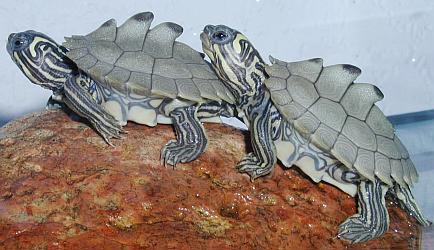As autumn approaches I invariably receive questions from reptile owners whose pets have lost interest in food. This most commonly occurs among Red Eared Sliders, Box and Painted Turtles, and other North American species, but may show up in lizards and snakes as well.
Amphibians in general, and reptiles from regions without a seasonal change, are largely immune. Bear in mind, however, that many species native to warm climates do experience a cool season – Bearded Dragons are a prime example, with certain populations hibernating in the wild.
Internal Controls on Behavior
It is common for native reptiles to slow down or stop feeding as the seasons change; often circadian rhythms (“internal clocks”) control this, and they will not feed even if kept warm. As long as the animals are otherwise in good health, they will be fine. We are learning that reptiles have amazing abilities to alter their metabolisms to suit local conditions (please see article below). Gharials (fish eating crocodilians) that I kept for 17 years at the Bronx Zoo went off feed annually, right in sync with wintertime in their native Pakistan. Despite being kept at 86-92 F, and moving about daily, they lost almost no weight over their 3 month fasting period.
Keeping Turtles in Winter
Sliders, Snapping Turtles and others that refuse to feed as fall approaches can be kept in water that is at average room temperature (65-68F) or a bit higher over the winter. Leave their UVB and basking lights on during the day, as they will continue to bask and move about. You can offer food 1-2x per week, but they will likely not eat much. Sick or stressed animals are another matter…please write in if you need advice.
Actually putting reptiles into true hibernation by lowering temperatures significantly is tricky, although often an important breeding stimulus. Please write in if you need further information.
Future Research -Your Observations Needed
One thing I’ve noticed, and which I’d like to research further, is that wild-caught turtles, even if taken into captivity on the day of hatching, usually stop feeding in the winter, while captive-hatched animals of the same species feed throughout the year. I would be very interested to hear from readers with similar or different experiences, thanks.
Further Reading
Please see Hibernation in Captive Bearded Dragons for specific information on these popular pets.
There is some amazing new information coming to light on snake metabolisms. Please check out How Snakes Grow During Times of Food Deprivation.
 That Reptile Blog – Reptile, Amphibian and Exotic Pet Care and Information
That Reptile Blog – Reptile, Amphibian and Exotic Pet Care and Information

 often fail to thrive if kept in bare surroundings. Hatchlings, even of common snapping turtles and other aggressive species, are consumed by predators ranging from giant water bugs to herons…most are always “on guard” and will refuse to eat unless given ample cover.
often fail to thrive if kept in bare surroundings. Hatchlings, even of common snapping turtles and other aggressive species, are consumed by predators ranging from giant water bugs to herons…most are always “on guard” and will refuse to eat unless given ample cover. The
The  Herpetologists and experienced turtle enthusiasts consider the wood turtle to be among the most intelligent of the turtles – in lab tests, they consistently scoring higher than other species on maze and reward-association tests. In my experience, captives exhibit a degree of curiosity and problem-solving abilities not evident in other turtles.
Herpetologists and experienced turtle enthusiasts consider the wood turtle to be among the most intelligent of the turtles – in lab tests, they consistently scoring higher than other species on maze and reward-association tests. In my experience, captives exhibit a degree of curiosity and problem-solving abilities not evident in other turtles. website. More important (infinitely more!) than my connection to NYTTS is their long standing relationship with legendary turtle biologist Peter Pritchard, who often speaks at the group’s day-long annual seminars. Rhom Whittaker, Mike Klemens, Roger Wood, Indraneil Das and numerous other notables have also participated in NYTTS sponsored programs.
website. More important (infinitely more!) than my connection to NYTTS is their long standing relationship with legendary turtle biologist Peter Pritchard, who often speaks at the group’s day-long annual seminars. Rhom Whittaker, Mike Klemens, Roger Wood, Indraneil Das and numerous other notables have also participated in NYTTS sponsored programs. conservation and natural history. Noted author and herpetologist Andy Highfield directs the organization, which is utilized by professionals and hobbyists alike.
conservation and natural history. Noted author and herpetologist Andy Highfield directs the organization, which is utilized by professionals and hobbyists alike. number of ways to participate in such. In addition to dozens of informative articles, one may also find photographs and even recordings of tortoise vocalizations on this most useful web site.
number of ways to participate in such. In addition to dozens of informative articles, one may also find photographs and even recordings of tortoise vocalizations on this most useful web site. Spurred tortoises are, however, the largest of all mainland tortoises, and may attain weights in excess of 200 pounds. Only one other mainland species, the yellow-footed tortoise (G. denticulata), gives the spurred any serious competition. A friend wrote me that he recently examined a 60 year old captive that weighed 190 pounds.
Spurred tortoises are, however, the largest of all mainland tortoises, and may attain weights in excess of 200 pounds. Only one other mainland species, the yellow-footed tortoise (G. denticulata), gives the spurred any serious competition. A friend wrote me that he recently examined a 60 year old captive that weighed 190 pounds. I took in the tortoise pictured here when its owner could no longer provide for it. He is currently at
I took in the tortoise pictured here when its owner could no longer provide for it. He is currently at